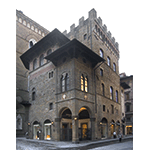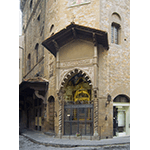Palagio dell'Arte della Lana [Palagio of the Wool Merchants Guild]
Built in the late 13th century by the powerful Wool Merchants Guild, whose headquarters it was as of 1308, as testified by a walled plaque, the building is formed by a tower-house adjoined by a lower construction. Its interior conserves fourteenth-century frescoes and it is connected with Orsanmichele by means of an overpass built in 1569 on a project by Bernardo Buontalenti. In the early 21th century, the palazzo was subjected to considerable renovation, and became headquarters of the Dante Society. Particularly interesting is the fourteenth-century fresco portraying several phases of wool working (today located in a shop on Via Calimala).
The Wool Merchants Guild developed a highly flourishing industry: in its period of greatest splendour, with its more than 300 workshops that worked more than 100,000 bolts of fabric per year, it employed one-third of the active population of Florence. The raw wool was beaten and washed; then it was rinsed in the Arno and laid out to dry on wicker trellises. After drying and combing, the "carders" proceeded to soften it: at this point, the wool was woven by women, even in their homes. The final operations were those concerning the delicate process of dyeing.
The wool industry was also tied to the exploitation of alum mines. This mineral made it possible to fix a dye on fabric by means of a procedure in which the Florentine workshops excelled, the secret of which has been lost. Genoa which had the monopoly on the diffusion of alum in Europe, imported it from Asia Minor until the Ottoman conquest made it necessary to find other supply sources. In 1461, a new deposit was found in Tolfa, situated about seventy kilometres northwest of Rome: the Medici succeeded in obtaining exploitation rights, but in 1476 the rights were acquired by their rivals, the Pazzi.
****************************
Texts by Antonella Gozzoli
English translation by Victor Beard
Last update 04/feb/2008





